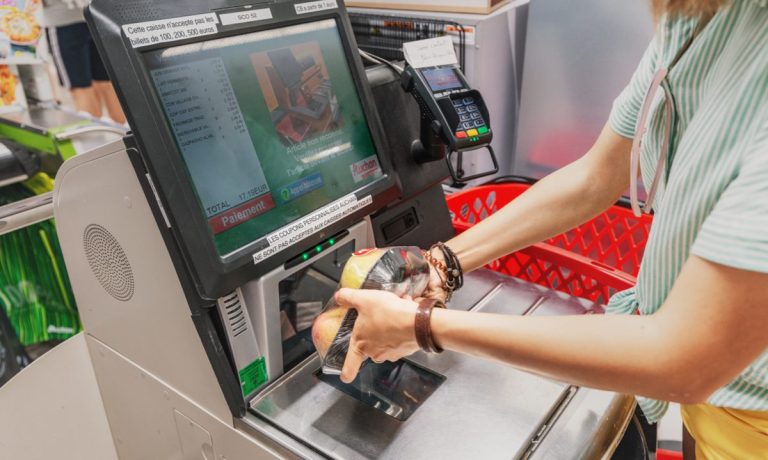Grocers’ Traditional Self-Checkout Kiosks Made Cautious Comeback in 2023

As new forms of self-checkout expanded across the global grocery industry throughout the year, key players found in 2023 that it is essential to continue to offer consumers familiar options.
Even the most tech-focused grocery retailers are noting this need. Take, for instance, Amazon, which has begun supplementing its Just Walk Out computer vision systems and its Dash Cart smart shopping carts with more traditional kiosks.
Over the summer, it was reported that the eCommerce giant is including traditional self-checkout lanes at new brick-and-mortar grocery stores under its Fresh concept, even at locations where Just Walk Out is available. Plus, reports throughout the year showed the company making such changes at locations in London.
Additionally, some grocers have been looking for ways to iterate on the self-checkout kiosk, making the experience more efficient while sticking with the basic model that consumers are familiar with.
United Kingdom grocery giant Tesco, for one, announced last month that it is adding scan-free kiosks to its Tesco Fulham Reach Express store. Consumers approach the devices, which then show a list of all the items the shopper has picked. The customer then reviews the list and pays, never having to scan each product — a change that reduces friction and boosts efficiency.
Some industry players think shoppers will not adopt new technology unless they can be eased into it, with familiar options available every step of the way.
“I think hybrid is the way forward,” Jordan Fisher, CEO of autonomous retail technology company Standard AI, said in an interview with PYMNTS posted in February. “If you imagine 10 years ago, when self-checkout was really starting to be deployed, if [retailers] had just said, ‘OK, it’s self-checkout everywhere — 100% has to be through self-checkout,’ it would have been a disaster. [You] need that hybrid, and we’re seeing the same thing with autonomous [checkout].”
In the United States, grocers are using kiosks to do more than just checkout. For instance, Ahold Delhaize subsidiary Giant Food, which has more than 160 locations, announced in the spring the arrival of its first in-supermarket fast-casual restaurant, a Nalley Fresh location, where consumers place their orders via self-service kiosks.
There is strong consumer demand for self-service options, per research highlighted in PYMNTS’ ”Digital-First Banking Tracker® Series Report.” The report cited findings that 84% of consumers in the U.S. said they enjoy using self-service kiosks, and two-thirds of individuals said they favor self-service models over staffed checkout lanes.
“Big Retail’s Innovation Mandate: Convenience and Personalization,” a PYMNTS Intelligence and ACI Worldwide collaboration, drew from a survey of 300 major retailers in the U.S. and the U.K. It found that 54% of convenience stores and pharmacies believe that shoppers would be very or extremely likely to switch merchants if self-checkout kiosks were not provided.
Still, a share of consumers is open to newer, more advanced self-service technologies at the grocery store, as PYMNTS Intelligence’s “How We Will Pay Report: How Connected Devices Enable Multitasking Among Digital-First Consumers” revealed.
The study found that, among the more than 95% of consumers who use internet-connected devices, 35% would be interested in an experience where they walk into a store and pick up a product, then walk out without standing in a checkout line to pay. Sensors detect what they have put in their cart, automatically charging them for those items using an app with the payment method. Six percent reported that they already use this checkout method.